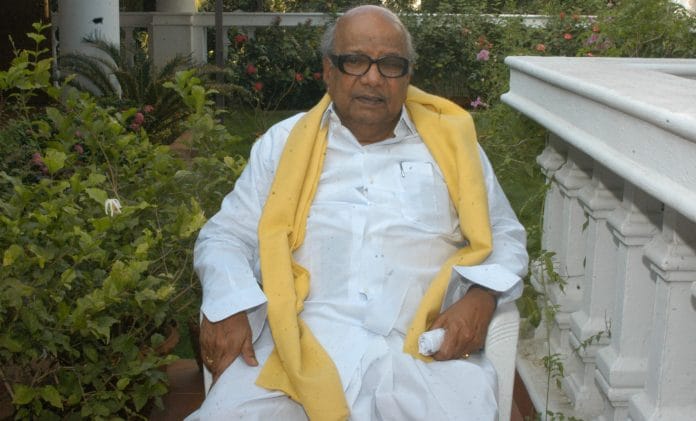It is doubtful if there can be another Karunanidhi in Tamil Nadu for years to come.
Just before the 2004 Lok Sabha polls, I met DMK chief ‘Kalaignar’ Karunanidhi at his Gopalapuram residence in Chennai. I asked him how he and other senior leaders like comrade Jyoti Basu accepted Congress chief Sonia Gandhi’s (a novice compared to them) leadership. He said that he was sure she would succeed. In a surprise result, the UPA defeated the Vajpayee government.
This was not the first time Karunanidhi’s prediction had come true.
Muthuvel Karunanidhi held sway for over five decades, and remained the party chief until he died. His son, Stalin, had recently written to the workers to celebrate the golden jubilee of Karunanidhi taking over the party on 27 July this year.
Hailing from a humble background, Karunanidhi was almost the last of that generation of leaders who had had to struggle to come up in life. Growing up amid the Dravidian movement of the 1930s, he began his life as an activist, journalist, and later became a scriptwriter who used films as a medium to spread his message. His autobiography Nenjukku Neethi gives a glimpse of his life and struggle.
Also read: The eternal flame of Dravidian politics is extinguished. Farewell, ‘Kalaignar’ Karunanidhi
When the first DMK chief minister C.N. Annadurai died in February 1969, Karunanidhi — known as a wily politician — succeeded him. He had held various positions in the house earlier and went on to win the elections in 1971. But once his colleague and film star M.G. Ramachandran (MGR) split the DMK by launching the Anna DMK in October 1972, it became tougher as the DMK and the ADMK (later AIADMK) were ideologically from the same stable of Dravidar Kazhagam of Periyar E.V. Ramasamy.
Karunanidhi weathered many political storms from then on. He opposed the Emergency, and Indira Gandhi dismissed his government in 1976. The DMK remained out of power for the next 13 years, but Karunanidhi’s leadership and organisational skills kept the party intact.
After MGR died in 1987, the DMK came to power in 1989 and joined the National Front led by V.P. Singh. Later, Prime Minister Chandra Shekhar dismissed Karunanidhi’s government in 1991 on allegations that he was helping the LTTE. The DMK lost power in 1991, in the aftermath of the assassination of Rajiv Gandhi, and AIADMK leader J. Jayalalithaa came to power in alliance with the Congress. But Karunanidhi bounced back in 1996 and joined the United Front to hold power at the Centre. The DMK became part of the NDA in 1999 and joined the Vajpayee government. He lost power in Tamil Nadu to the AIADMK in 2001, but joined the UPA government at the Centre in 2004 and continued to do so in 2009.
After losing the 2011 assembly and the 2014 Lok Sabha polls and facing corruption allegations in the 2G spectrum scam, the DMK has been on the back foot. In 2016, it won 100 seats but failed to win power.
Since the death of Jayalalithaa in December 2016, the ailing Karunanidhi also became less visible in public life.
Despite not speaking English or Hindi, Karunanidhi played a crucial role in national politics. During the 1969 Congress split, he supported Indira Gandhi. When Jayaprakash Narayan launched the Janata Party, the DMK was part of it. He joined many coalitions like the National Front, United Front, the NDA, the UPA and held power at the Centre. He had a comfortable relationship with several national leaders. He declined to be the Prime Minister in 1997 when H.D. Deve Gowda stepped down. Karunanidhi’s answer was, “En uyaram ennuku theriyum (I know my height)”.
Also read: Karunanidhi ensured DMK representation at Centre & in state like no other regional leader
He led a colourful life with three spouses, four sons and a daughter. He was accused of nepotism and promoting dynastic politics. Years ago, Karunanidhi had declared his eldest son M.K. Muthu as a persona non grata in the party. MDMK chief ‘Vaiko’ Vaiyapuri Gopalsamy left the party when Karunanidhi projected his younger son M.K. Stalin in the 1990s. Later, he chose Stalin as his political heir, ignoring the claims of the middle son M.K. Alagiri. The sibling rivalry also affected his daughter, Kanimozhi, who is a Rajya Sabha MP.
Karunanidhi played a crucial part in Indo-Sri Lankan relations, particularly during the LTTE war.
It is doubtful whether there can be another Karunanidhi in Tamil Nadu for years to come, and his place is written in golden letters.






